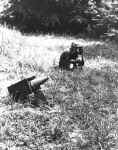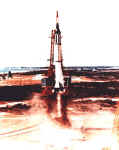1961
1961 The United States purchased the French SS-11B armament subsystem for helicopters and designated it as the M22 missile system. The system was type classified as Standard Limited Production.
January 61 Beginning this month and continuing into March 61, the first two Phase II LITTLEJOHN battalions were activated.
31 January 61 The second MERCURY-REDSTONE (MR-2) test flight carried a chimpanzee named Ham into space. This suborbital mission helped prove the system's operational capabilities in a space environment. Ham survived the flight safely.
6 February 61 The ABMA/ARGMA realignment was completed on this date when ABMA assumed those functions related to supply management, cataloguing, ADP and EAM operations, documentation, and engineering laboratory services, and secondary item acquisition that had remained with ARGMA after the main transfer of weapon systems to ABMA.
28 February 61 A fire at the Rocket Research Facility at Fort Churchill, Canada, virtually destroyed the capability for launching rockets. Originating in the generator room, the fire ruined the block house and preparation building as well as adjacent facilities. Consequently, until July 61, only three rockets (AEROBEE 100s) were fired at the facility, all with special AOMC safety procedures.
March 61 The LAW was type classified Standard A and designated as Rocket, HE 66MM AT M72.
22 March 61 DA decided to procure the French Engin Teleguided Anti-Char (ENTAC) antitank system for the U.S. Army infantry.

30 March 61 The Secretary of Defense announced the inactivation of four ordnance depots and one depot activity, the latter the Redstone Depot. These depots were to be phased out over the next 3 years. As a result of this plan, the Explosives and Services Division was established on 1 October 61 to perform necessary support functions which were to continue after the depot was closed.
April 61 Three cafeterias and five snack bars were transferred to NASA from the RSA Post Exchange Division. Transfer of these facilities resulted in a loss of about $360,000 in sales annually.
13 April 61 The ENTAC system in the ground launch mode was type classified Standard A. The system was a solid propellant, wire-guided missile for use against enemy tanks, armored combat vehicles, and certain defensive installations such as bunkers and enemy emplace-ments. Developed by the French government and produced by Nord Aviation of Paris, the ENTAC was especially suitable for use by the infantry since it weighed only 37.5 pounds complete with its launcher.
22 April 61 JUPITER Missile 209, the first Combat Training Launch missile, was successfully fired from AMR by Italian air force personnel.
18 May 61 A USMC captain successfully fired the first ejector-only REDEYE from a shoulder-launch position. He suffered no ill effects from noise, recoil, or heat.
May 61 The U.S. Army officially decided to buy the ENTAC to replace the SS-10. DA assigned responsibility to AOMC for the procurement, testing, evaluation, and management of the U.S. ENTAC program.
5 May 61 MERCURY-REDSTONE 3 (MR-3) carried CDR Alan B. Shepard, Jr. on his historic suborbital flight.

31 May 61 DOD approved the installation of a "big dish" (84-foot) radar antenna on Madkin Mountain, RSA.
Thomas M. Moore June 61 Tests on the Small Rocket Lift Device (Jump Belt) under Phase I, were completed during this month. It was concluded that the system design was safe and reliable enough to proceed with manned tethered and free-flight testing. Also known as the "Jet Vest," design fabrication and static testing of the device was conducted under contract between the U.S. Army Transportation Research Command and Bell Aerosystems Company.
1 June 61 The name Redstone Arsenal became a geographical location only when the Army Ordnance Missile Support Agency (AOMSA) replaced RSA as the support element for the arsenal complex. The name Redstone Arsenal continued to identify the 38,000-acre installation and served as the mailing address and official home of AOMC, AOMSA, ABMA, ARGMA, and OGMS.
26 June 61 REDSTONE Missile 2043 was fired from AMR to a predetermined range of 173,869 nautical miles, bringing the Engineering Qualification of Production Missiles (EQPM) program to a successful end. The EQPM program began in April 60.
30 June 61 Redstone Arsenal initially planned to retire the 300 Lanham Act Housing (Redstone Park) units from use because they were substandard. However, because of the urgent need for dependent quarters, DA granted a request from the AOMSA Commander to retain these units for an indefinite period.
Built during World War II, turned over to the Huntsville Housing Authority after the war, then reclaimed by the Army in April 56, these units were used to house families of soldiers in the first five enlisted grades, usually on a temporary basis pending the availability of better quarters.
July to December 61 The combined AOMC organizations at Redstone--Headquarters AOMC, ABMA, ARGMA, and AOMSA--received the FY 1961 Army Award of Merit for Safety. This was the first time this award had been presented at the arsenal.
21 July 61 The last MERCURY-REDSTONE (MR-4) flight carried CPT Virgil I. Grissom to a peak altitude of 118 miles and safely landed him 303 miles downrange.

17 August 61 A dedication ceremony for the newly renovated U.S. Army Hospital (Building 112) was held. The new hospital was opened for full occupancy on 21 August, while the old hospital building became the new home for the Occupational Health Service.

September 61 The last R&D test rounds for the LAW were fired.
15 September 61 The first guided firing of a SHILLELAGH test vehicle was conducted.
28 September 61 The SERGEANT development program was essentially completed with the flight of the last R&D missile.
October 61 The Martin Marietta Corporation received the first production contract for PERSHING I tactical missiles and GSE.
12 October 61 An Army first lieutenant assigned to the REDEYE project staff at ARGMA successfully shoulder fired the REDEYE in its first public appearance during a special weapons demonstration at Fort Bragg, North Carolina. Witnessing the display were over 300 spectators, including President John F. Kennedy, Secretary of Defense Robert S. McNamara, and Secretary of the Army Elvis T. Stahr, Jr.
16 October 61 The Assistant Secretary of the Army (R&D) and the Secretary of Defense approved a plan which called for inhouse and contractor studies to prove the feasibility of the TOW antitank missile system before the start of a large and costly development program.
16 October 61 OCO established the Office of the Project Manager, MAULER at AOMC Headquarters (actually, at ARGMA until the consolidation). This was the first time a project manager had been located "on the scene" where a weapon system was being developed. Previously, project managers had operated from the OCO.
November 61 The Phase II LITTLEJOHN weapon system was first deployed to Okinawa with the 1st Missile Battalion, 57th Field Artillery.
11 December 61 As part of a sweeping command reorganization, both ABMA and ARGMA were abolished and their functions and personnel were merged with AOMC Headquarters.
12 December 61 Effective this date, the combined MAULER-REDEYE Project Office was established at AOMC.
31 December 61 Except for technical assistance, Army responsibility for JUPITER program support ended.
The ABMA/AOMC Era:
Introduction,
1956,
1957,
1958,
1959,
1960,
1961
1962
